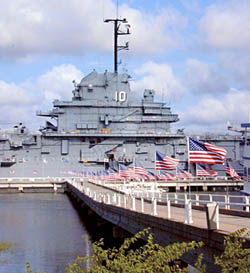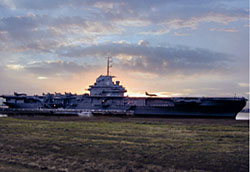
Located in Mount Pleasant, South Carolina, the USSYorktown (CV-10), the second Essex class carrier built by the United States, was commissioned on April 15, 1943. As early as 1910, the U.S. Navy recognized the potential value that flight would have in naval operations. Although naval aviation was utilized during World War I, aircraft assigned to warships generally provided only reconnaissance support for the fleet. The possibility of using airplanes as a naval strike weapon did not begin until the 1920s when aircraft capable of performing heavy bombardment against land or sea targets were built. Naval vessels capable of carrying several squadrons of such aircraft were developed concurrently. Thus the first eight carriers constructed by the U.S. Navy varied in size, speed, protection and aircraft complement in order to provide the greatest number of carriers capable of launching the greatest number of air strikes, yet still comply with treaty-imposed tonnage restrictions. Essex (CV-9), the ninth U.S. carrier authorized, was a product of these earlier designs.
A total of 26 Esssex-class carriers were ordered by the U.S. Navy between February 1940 and June 1943 and 24 were completed. This was the largest class of carriers ever built by the United States and over half, including USS Yorktown (CV-10), served as part of the Pacific Fleet during World War II. World War II and the carrier campaigns of the Pacific firmly established the role of aviation within naval operations and the aircraft carrier replaced the battleship as the Navy's primary strike weapon. Serving as mobile air bases, carriers could maneuver aircraft around the open waters and scattered island chains of the Pacific. By employing a combination of scouting, fighter or bomber aircraft to control the enemy's air power, groups of carriers, screened by surface ships, could open the way for island invasions, cover and support amphibious operations, and help to hold the conquered areas. Thus carriers became an integral compound of nearly every campaign throughout the Pacific War. With aircraft that extended the fleet's firepower beyond the range of large caliber battleship guns, the carrier's status was elevated from reconnaissance platform to that of major surface combatant.

Named for the CV-5 aircraft carrier that was sunk during the Battle of Midway, the new USS Yorktownhad a distinguished war record, receiving 11 battle stars and a Presidential Unit Citation for its World War II services. During World War II, the USSYorktown fought against the Japanese for more than two years, inflicting heavy damage on the Japanese at Truk and the Marianas, helping sink the largest battleship ever built, the Imperial Japanese Navy'sYamato and supporting American ground troops in the Philippines, at Iwo Jima and at Okinawa. The USS Yorktown was converted for jet use in 1955 with the addition of a new angled flight deck, hurricane bow and flight deck. It then served as an anti-submarine carrier in Vietnam. In 1968 the Essex class carrier was used to recover the crew of Apollo 8, the first manned mission to orbit the moon. Before being decommissioned in 1970, the USS Yorktown had a notable career in the service of the United States.
Visit the National Park Service Travel American Aviation to learn more about Aviation related Historic Sites.
Last updated: August 22, 2017
